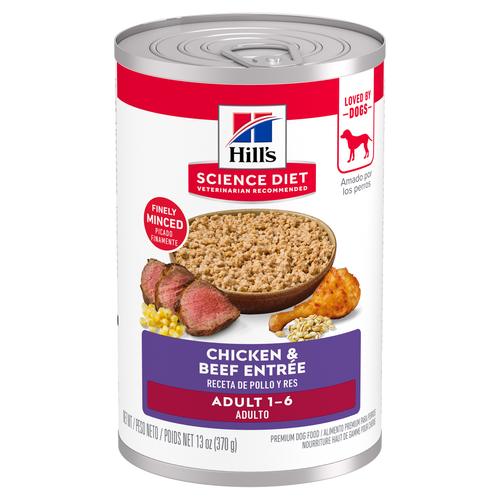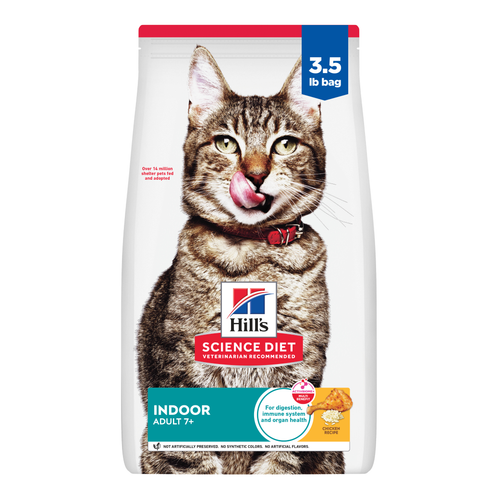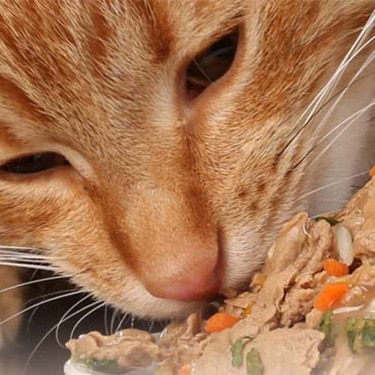
-
Find the right food for your petTake this quiz to see which food may be the best for your furry friend.Find the right food for your petTake this quiz to see which food may be the best for your furry friend.Featured products
 Adult Large Breed Chicken & Barley Recipe Dog Food
Adult Large Breed Chicken & Barley Recipe Dog FoodSupports healthy joints, lean muscle, and beautiful coat for large breed dogs
Shop Now Adult Chicken & Barley Recipe Dog Food
Adult Chicken & Barley Recipe Dog FoodSupports lean muscle and beautiful coat for adult dogs
Shop Now Hill's Science Diet Adult Chicken & Beef Entrée Dog Food
Hill's Science Diet Adult Chicken & Beef Entrée Dog FoodChicken & Beef Entrée in a delicious loaf with complete & balanced nutrition to help keep adult dogs active and healthy
Shop NowFeatured products Senior Vitality Adult 7+ Tuna & Vegetables Stew
Senior Vitality Adult 7+ Tuna & Vegetables StewImproves Everyday Ability to Get Up & Go
Shop Now Adult Turkey & Liver Entrée Cat Food
Adult Turkey & Liver Entrée Cat FoodPrecisely balanced nutrition with the delicious taste of minced turkey & liver to help fuel the energy needs of cats during the prime of their life
Shop Now Adult 7+ Indoor Chicken Recipe Cat Food
Adult 7+ Indoor Chicken Recipe Cat FoodSupports energy level and beautiful fur in mature indoor cats
Shop Now -
Dog
- Dog Tips & Articles
-
Health Category
- Weight
- Food & Environmental Sensitivities
- Urinary
- Digestive
- Joint
- Kidney
-
Life Stage
- Puppy Nutrition
- Adult Nutrition
- Senior Nutrition
Cat- Cat Tips & Articles
-
Health Category
- Weight
- Skin & Food Sensitivities
- Urinary
- Digestive
- Kidney
-
Life Stage
- Kitten Nutrition
- Adult Nutrition
Featured articles The Science Behind Our Love for Pets
The Science Behind Our Love for PetsLearn the scientific reasons why we have such strong connections with our pets, and what science says about the love between humans and our furry friends.
Read More What Is Littermate Syndrome? Pet Adoption Guide
What Is Littermate Syndrome? Pet Adoption GuideLearn more about littermate syndrome in dogs and cats and how to successfully navigate adoption and early socialization processes.
Read More How to Properly Mix Wet & Dry Pet Foods
How to Properly Mix Wet & Dry Pet FoodsAn Orange cat eating from a bowl filled with mixed food
Read More -


If one or both of your dog's eyes look cloudy, it's possible that your dog has cataracts. Fortunately, cataracts treatment for dogs is successful for the majority of patients.
What Are Cataracts in Dogs?
Inside the eye is a structure called the lens. When light enters the eye, the lens focuses the light on the back of the retina. When a cataract forms, the lens becomes opaque, causing blurry vision.
Cataracts may be passed down genetically, meaning any dog is at risk of the disease. According to the American College of Veterinary Ophthalmologists, diabetes mellitus (aka sugar diabetes) is the most common disease associated with cataracts. Trauma to the eye and chronic eye disease or infection may also lead to the development of cataracts.
Risk Factors
Though cataracts are often considered to be a characteristic of senior pets, dogs can develop cataracts at any age. Puppies can even be born with cataracts. When an animal is born with this condition, it's called congenital cataracts.
Some dog breeds are more likely to develop the condition than others. According to the University of Illinois at Urbana-Champaign College of Veterinary Medicine, breeds at a higher risk of cataracts include the cocker spaniel, Labrador retriever, poodle, Shih Tzu, schnauzer and Boston terrier.

What Do Cataracts Look Like in Dogs?
The most visible symptom of cataract in dogs are a cloudy appearance to the eyes. In some cases, you may see a white spot or streak. The affected eye can even take on an icy appearance. As a cataract progresses, the cloudiness prevents light from being focused and reaching the retina, which causes your pup to suffer vision loss.
There are different stages of cataracts in dogs. However, it's difficult to determine whether a cataract will progress and, if so, to what extent. Pet parents may first notice the cataract when it's classified as immature, meaning that it covers a noticeable portion of the lens — anywhere from less than half of the lens to nearly all of it. Vision is typically impaired at this point, but the dog may be able to compensate surprisingly well. Before this stage, cataracts in dogs are referred to as incipient, meaning they are ever so slight and likely to be missed by the naked nonprofessional eye. If a cataract progresses and covers the rest of the healthy lens, it's called a mature cataract. Mature cataracts in both eyes result in complete blindness.
To complicate things, not all cases of eye cloudiness are due to cataracts in dogs. As dogs age, the lenses in their eyes harden and can turn a milky gray color. This is a normal aging change called nuclear or lenticular sclerosis, and it doesn't affect vision. Your veterinarian will be able to distinguish between nuclear sclerosis and cataracts — which, despite their similar appearances, are distinct.


Tasty Tips
Cataracts Treatment for Dogs
Early stage cataracts often don't necessitate treatment, as the dog's vision may not be affected. As lens changes progress, however, the dog's vision will continue to decline. Surgical cataracts treatment for dogs has been around for decades and is quite successful. Because most dogs with cataracts are able to compensate for their vision loss through the use of their other strong senses, treatment is considered elective.
Your vet will likely refer you to a board-certified veterinary ophthalmologist so your dog can have a consultation to see whether they're a good candidate for surgery. The ophthalmologist will perform a test called an electroretinogram to check the functionality of your dog's retina, along with an ultrasound of the eye to ensure the retina is fully attached.
The surgery is fast and consists of a surgeon making a tiny incision through which the affected lens can be removed. After the operation, your dog will need to take medicine and see the vet for rechecks. Most dogs regain vision and are back up and playing in a matter of days.
If surgery isn't an option, it's important to control the disease process in the eye resulting from the cataract. Cataracts can cause lens shifting or glaucoma, both of which require intervention.
Prevention
Cataracts that form as a result of diabetes mellitus may be preventable. The key is to keep your dog at a healthy weight by feeding them a balanced food with all of the proper nutrients and to follow any advice that your vet gives you.
Unfortunately, there's no way to prevent cataracts that have a hereditary component. If you decide to adopt a puppy or an adult dog from a breeder, choose a breeder who screens for cataracts. While this isn't an option if you choose to adopt your newest canine family member, have your veterinarian investigate at the first sign of any eye abnormalities or vision trouble. This way, you can help keep your dog's eyes healthy and their vision clear long into their golden years.


Dr. Laci Schaible is a small animal veterinarian, veterinary journalist, and a thought leader in the industry. She received her Doctor of Veterinary Medicine from Texas A&M University and her Masters in Legal Studies from Wake Forest University.
Related products

Supports healthy joints, lean muscle, and beautiful coat for large breed dogs

Chicken & Barley Entrée in a delicious loaf with great taste and precisely balanced nutrition to support 5 essential building blocks for lifelong health

Supports lean muscle and beautiful coat for adult dogs

Chicken & Beef Entrée in a delicious loaf with complete & balanced nutrition to help keep adult dogs active and healthy
Related articles

Learn how to help keep your dog's immune system in tip-top shape, including nutritional immune system support for dogs and other strategies.

Your dog's coat and skin are a big part of your dog's overall health. Ensure you keep your dog's coat healthy, by following these simple tips.

Wondering where can I buy a dog? Consider adoption and explore the pros and cons of adopting a dog from a breeder versus an animal shelter.

Discover how the field of dog science is giving us more and more insights into the inner workings of our furry best friends.

Put your dog on a diet without them knowing
Our low calorie formula helps you control your dog's weight. It's packed with high-quality protein for building lean muscles, and made with purposeful ingredients for a flavorful, nutritious meal. Clinically proven antioxidants, Vitamin C+E, help promote a healthy immune system.
Put your dog on a diet without them knowing
Our low calorie formula helps you control your dog's weight. It's packed with high-quality protein for building lean muscles, and made with purposeful ingredients for a flavorful, nutritious meal. Clinically proven antioxidants, Vitamin C+E, help promote a healthy immune system.

